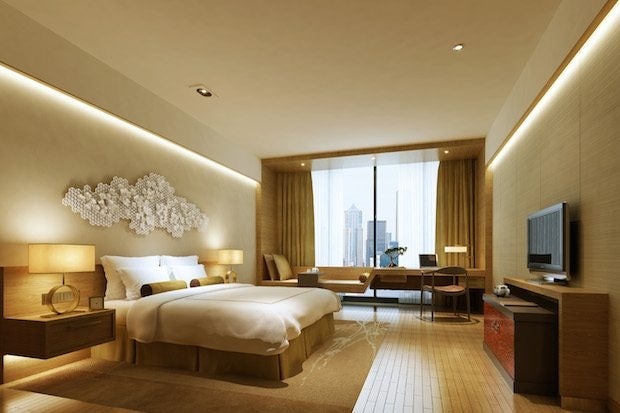
A rendering of a planned Hualuxe hotel room. (KOKAISTUDIOS)
This week, Hualuxe Hotels and Resorts—an imprint of InterContinental Hotels Group (IHG) designed specifically for Chinese consumers—announced the locations of its first two properties: Nanchang, capital of southeastern Jiangxi Province, and Yangjiang, Guangdong.
Initially unveiled in spring 2012, the Hualuxe concept, as Jing Daily wrote at the time, “is maximized for localization, with features including a tea house rather than a traditional bar, restaurants that offer local cuisine rather than fine dining, and foot massage studios rather than a spa.”
As IHG said in 2012, the majority of Hualuxe properties were to be built in second- and third-tier cities, along with Beijing and Shanghai, and “located in more than 100 cities throughout China within the next 15-20 years.” These ambitious goals were emblematic of the luxury boom times of 2011-2012, as opposed to the more austere turn the domestic market has taken over the past two years.
That said, the company does seem to be sticking to its mission of targeting second- and third-tier cities, considering it chose Nanchang and Yangjiang to debut Hualuxe.
According to IHG CEO Richard Solomons, Hualuxe “was built on over three decades of market insight, experience and leadership in China and epitomizes the finest elements of China’s world-renowned hospitality.” Solomons reiterated his plans to take Hualuxe to over 100 cities in the Greater China region within the next two decades, adding that he thinks Hualuxe hotels “will be welcomed by both Chinese and international consumers.”
IHG’s optimism is refreshing considering the tepid spending on high-end hotels seen in China since the launch of Xi Jinping’s ongoing anti-corruption crusade. Hotels catering to the government banquet crowd—which is most of the domestic five-star hotels in the country—have been among the hardest hit, and many hotels have even spent the last year voluntarily shedding stars to accommodate official bans on spending at "luxury" venues.
Hualuxe is also entering the market where second-tier cities are far from a safe high-end bet. While top-tier cities have reported decent occupancy rates—Shanghai reported an increase of 8.5 percent in December to 71.9 percent—the same cannot be said for second- and third-tier cities like Xi’an, where luxury hotels are slashing room rates in an attempt to boost occupancy.
All things considered, IHG is far from a naïve company, and likely sees China’s current luxury-as-four-letter-word environment as a short-term blip in a long-term investment in the country. On a more general level, domestic tourism is expected to continue growing—though not, perhaps, in cities like Nanchang—with Beijing setting the ambitious goal of increasing spending by domestic Chinese tourists to 5.5 trillion yuan ($894 billion) by 2020. Only time will tell if Hualuxe ultimately benefits from this expected growth or is overshadowed by the numerous other hotel players in an already contentious and crowded market.